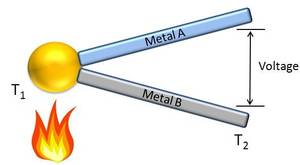A group of Korean researchers have produced flexible films of thermoelectric material that can generate electricity with nothing more than the heat produced by a fingertip.
fingertip.
Thermoelectric materials can harvest heat and convert it into useable electricity, by acting as heat engines.
They depend upon a temperature difference to "drive" the conversion from heat to electricity - so one side needs to be hot and the other side cold.
This temperature difference makes the electrons on the "hot" side vibrate more vigorously so they tend to move towards the colder side where the electrons are moving more slowly. This movement gives rise to a current that can be tapped off as electricity.
Thermoelectric devices are already widely used, but most commercial devices are made from solid-state semiconducting materials, which are expensive to produce, often toxic and they need a large temperature difference to operate.
So, recent efforts to develop flexible, non-toxic organic thermoelectric polymers is gaining interest - these materials are cheap and easy to produce and, with some clever chemistry, can harvest electricity from very small temperature differences.
But there are challenges. The ability of a thermoelectric material to convert heat into electricity is defined by its power factor, a number related to its electrical conductivity.
The best thermoelectrics have high electrical conductivity, meaning that they allow electrons in the material to flow freely.
Generally, the materials used for organic thermoelectrics - conductive polymers - have low electrical conductivities, and this limits the thermoelectric power factor.
Now, Eunkyoung Kim and his team at Yonsei University in South Korea have developed a new thermoelectric material based on a material called PEDOT - poly(3,4-ethylenedioxythiophene) - which, they claim, shows a power factor of 1270 µW/mK2 - four times higher than any other conductive polymer published in the literature.
This means that it can harvest the tiniest amount of heat - even that produced by placing a fingertip on top of the material.
The PEDOT polymer was produced using standard large area film processing techniques. Kim and his team also used electrochemistry to control oxidation inside the film, and so optimised its electrical properties to produce this record breaking thermoelectric power factor. The material also has the added benefit of being very flexible - unlike many commercial thermoelectric materials.
By printing gold electrodes directly onto the PEDOT film, the team measured the voltage produced as one side of the film was cooled while the other was touched by a fingertip.
The PEDOT film produced 590 µV of electricity under a temperature difference of approximately 5 °C.
This may be five times smaller than the voltage produced by traditional, solid-state thermoelectric materials, but PEDOT films can be produced at a tiny fraction of the cost and many times more rapidly than these materials, so there are obvious gains to this technology.
It's fair to say that, with these miniscule amounts of electricity, we're unlikely to be wearing gloves that will charge up a phone or an iPod any time soon. But, the potential applications of these films are numerous. Many of today's sensors and microelectronic devices need only a few microvolts of electricity to operate, and these cheap, flexible, non-toxic films can produce that with only a tiny temperature gradient.
For thermoelectrics, it seems, the future may indeed be flexible.
- Previous Salmon make mental magnetic map
- Next The Demise of the Dinosaurs










Comments
Add a comment